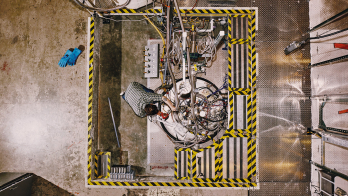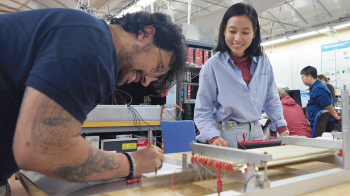On 1 February 2005, the cavern for the CMS detector at CERN was inaugurated in a ceremony attended by many guests, including the Spanish and Italian ambassadors to the United Nations and representatives of the construction companies.

The hand-over of this cavern, a gigantic underground structure 100 m underground near the village of Cessy in France, marks the end of the large-scale civil-engineering work for the Large Hadron Collider (LHC) at CERN.
The second of the new caverns for the LHC experiments, the CMS cavern is the result of several years of work by a consortium of Italian, Spanish, British, Austrian and Swiss civil-engineering companies. Problems arising from the local geology made it a spectacular feat of engineering.
The new structures built for CMS in fact comprise two caverns, together with two access shafts, for which 250,000 m3 of spoil had to be removed. The cavern for the detector is 53 m long, 27 m wide and 24 m high. The second cavern, housing the technical services, is adjacent. Unlike the strategy for the ATLAS detector, the various components for the CMS detector are being assembled and tested in a surface building before being lowered into the cavern, starting next January.
Work began six-and-a-half years ago with the excavation of the two access shafts. This was not an easy task given the 50 m deep stratum of extremely unstable moraine that also contains two water tables. To excavate this loose, wet earth, a ground-freezing technique was used, which involved circulating a brine solution at a temperature of -23 °C, followed by liquid nitrogen.
The molasse between the two caverns, which was too weak to withstand the high levels of stress exerted on it, presented a further difficulty and had to be replaced by a huge pillar of reinforced concrete.
To control the environmental impact of the project, special attention was paid to water treatment and to minimizing dust and noise levels. Moreover, the tonnes of spoil were deposited in the immediate vicinity, avoiding noise and disruption on the roads of the nearby villages. These storage areas are being landscaped and will be planted with vegetation between now and June 2005.








